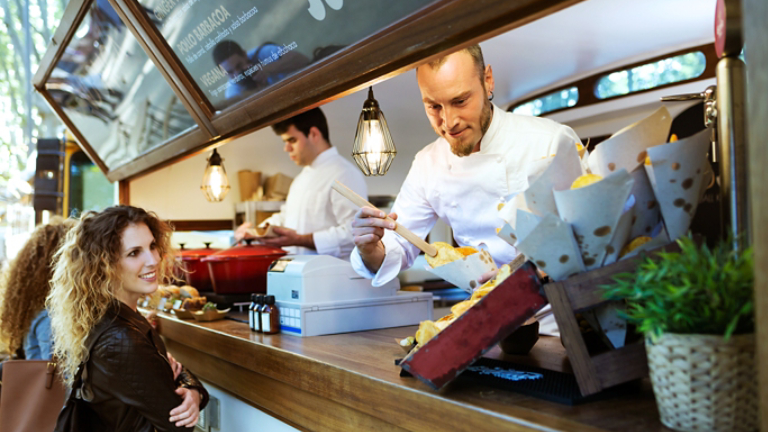Advancements in heating, ventilation and air conditioning (HVAC) technology have given restaurants a powerful system with a dual purpose—chilling refrigeration appliances while keeping facilities comfortable.
The efficiency-minded glycol chiller refrigeration system uses a single rooftop unit to improve refrigeration reliability and help owners realize savings through reduced maintenance and repair costs.
Early glycol chiller adopter Lucille’s Smokehouse Bar-B-Que, a West Coast chain of restaurants in the Hofman Hospitality Group, expects the system to lower its energy and repair and maintenance costs by up to 90 percent.
Traditional refrigeration methods would have meant $8,000 in year-five repair and maintenance costs for Lucille’s. With the glycol system, Ryan Hofman, director of facilities and construction for the Hofman Hospitality Group, expects those costs to be approximately $800 or less in year five.
“We’ve been working very aggressively over the last few years to implement a refrigeration standard that’s repeatable, reliable and proven long term,” Hofman said. “Once you start seeing the bills coming in at $15,000 or $20,000 a year for refrigeration repair and maintenance at a single location, it’s justifiable to replace the entire system. We’d rather invest more on the front end to avoid spending a lot of money on repair and maintenance in the long run.”
The problem with “industry standard” refrigeration methods
For decades, many restaurants have used standalone direct expansion (DX) units to chill kitchen fixtures. However, the associated maintenance and repair costs of remote and self-contained refrigeration systems became a concern. The group struggled with compressor/condenser failures, refrigeration leaks and icing components without a reliable defrost method.
Problems with the self-contained DX unit often begin with its multiple compressors and condensers. Each compressor and condenser contains parts that are prone to high failure rates—especially as they age. A DX system fills a restaurant kitchen with potential headaches and logistical nightmares should any of these cooling appliances quit working.
The traditional DX refrigeration system also places an additional load on a restaurant’s air conditioning system. It introduces additional heat into the kitchen, which leads to more AC use and higher initial and operating costs. This can be especially problematic in warmer locations, where ambient air temperature already might be an issue.
Simplicity of the glycol chiller system
Where a self-contained refrigeration unit has dozens of moving parts and components, a glycol chiller system keeps things cool with one major component—a rooftop chiller.
Glycol chiller systems connect each fixture in a restaurant kitchen—walk-in coolers, refrigerators, under-counter evaporators and pan chillers—to the rooftop unit. The chiller’s compressors cool the glycol/water solution using a heat exchanger. The solution then circulates to cool the kitchen fixtures as needed. In addition, the glycol can be used to chill the condensers of the other DX systems like ice machines, which helps make ice faster and keeps the unit operating efficiently, longer.
Each fixture has supply and return lines connecting it to the chiller unit. The glycol/water solution is pumped in and out at a low pressure, which helps prevent the leaks that are more likely in higher pressured refrigerated systems.
The low-pressure system also enables restaurants to utilize PEX piping for many of the connections, which is more affordable and faster to install than copper piping.
Key benefits of glycol chillers for restaurant solutions:
- Initial glycol chiller system investment can be less than self-contained refrigeration, since it involves purchasing one glycol chiller unit versus numerous smaller units.
- Smaller units also take up significant kitchen space with compressor cabinets that require “breathing room.”
- Rooftop placement of the chiller reduces or eliminates the number of high-failure parts inside the kitchen and allows maintenance and repair to be done without disrupting food preparation or kitchen service.
- Optional heat reclaim technology allows heat removed from the chilled fixtures to be recycled and used to heat kitchen water. This technology keeps the boiler from working as hard to heat water, which saves energy instead of wasting it into the ambient air.
- Finally, the lifetime usage of the glycol chiller system is expected to double—up to 20 years compared to 10 years for the previous system.
Hofman Hospitality Group decided to make the switch to glycol chiller systems for Lucille’s kitchens to address inefficiencies and costs from traditional refrigeration methods.
“It works extremely reliably; it’s very high performance. We’ve been really happy with it,” Hofman said. “I think this is the system for us moving forward. All our new stores are going to use glycol chillers.”
This post was adapted from an article written by Jeff Swanson that originally appeared in the March 2014 issue of Restaurant Facility Manager. Read the complete article.


